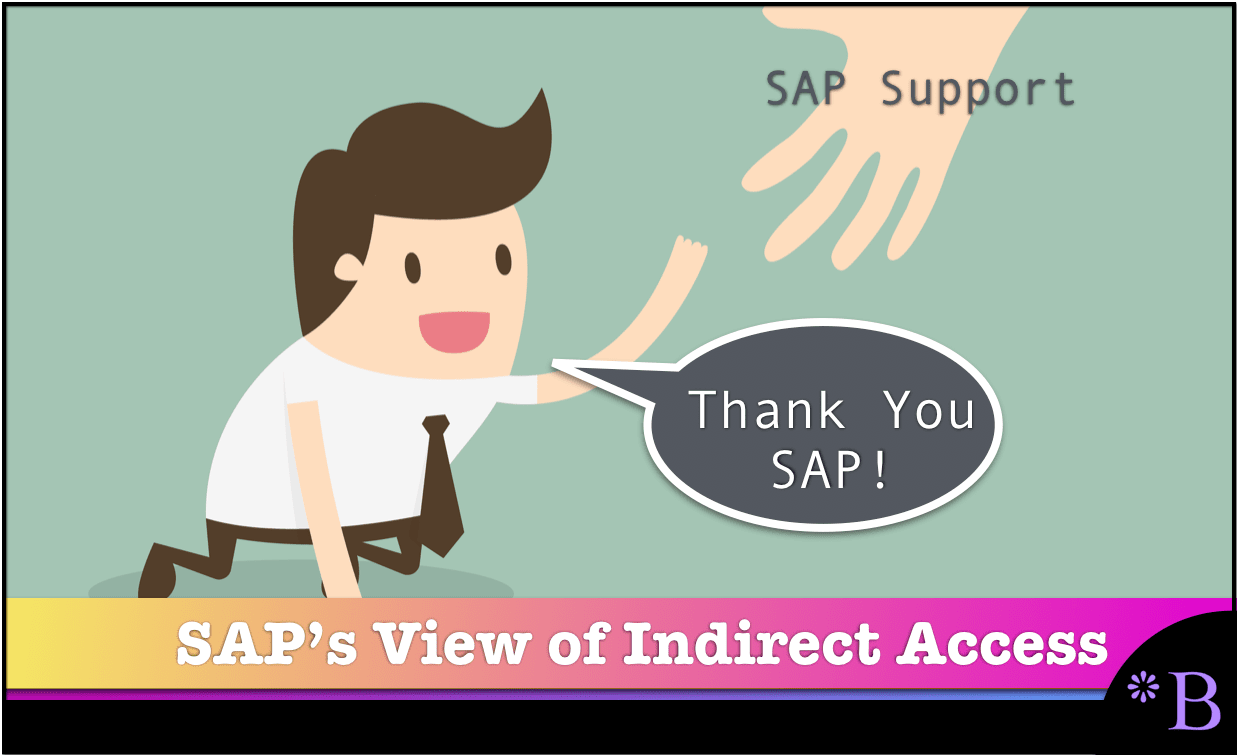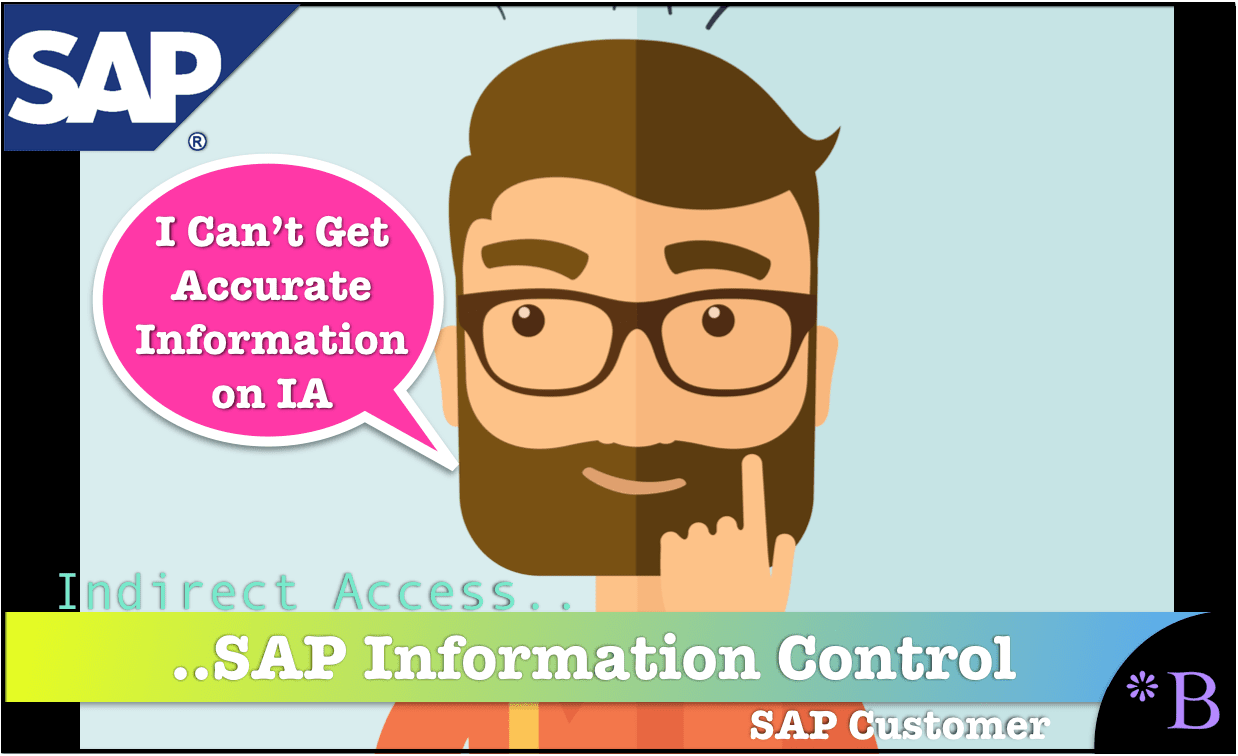According to SAP, Indirect Access is All About Customers!
Executive Summary
- There are plenty of firms that perform SAP advisement, but the advice ends up being rigged.
- Large companies use advisement to provide advice that leads to other businesses.

Video Introduction: According to SAP, Indirect Access is All About Customers!
Text Introduction (Skip if You Watched the Video)
SAP published an article that proposed a curious narrative for how SAP views how SAP charges customers or indirect access. After strip mining customers with its fake indirect access concoction, Bill McDermott came up with the idea that SAP should be empathetic towards its customers and then lies about SAP licensing being separate from sales. SAP used ComputerWorld, as paid off media entity by SAP, to present a sanitized version of SAP’s behavior and ComputerWorld served as a parrot for SAP. Under this proposal, SAP has rolled out indirect access in order to help its customers. You will learn about the accuracy of SAP’s statements on indirect access.
Our References for This Article
If you want to see our references for this article and other related Brightwork articles, see this link.
Notice of Lack of Financial Bias: We have no financial ties to SAP or any other entity mentioned in this article.
ComputerWeekly’s UKIR Conference
ComputerWeekly is one of the many IT media entities that take income from SAP to promote their message. We will begin by evaluating statements around the customer orientation of indirect access in the ComputerWeekly SAP UKIR conference.
Is SAP Updating Indirect Access Policy?
“And almost 50% were also unaware of SAP’s attempts to update its indirect licensing policy in line with how enterprise resource planning (ERP) systems are accessed now, as against in the 1980s.”
The version that SAP is enforcing against its customer’s something that we have called Type 2 indirect access — and it is an invalid claim. To understand Type 2 indirect access see the article Type 1 Versus Type 2 Indirect Access.
It is also in violation of the Tying Agreement clause of US anti-trust law, which you can read in the extensive article How SAP’s Indirect Access Violates the Tying Agreement of and US Anti Trust Law.
Therefore, there is no reason for SAP to “update” its indirect access policy. All they need to do is stop enforcing illegal licensing against their customers. Secondly, every time SAP “updates” its indirect access licensing, SAP tightens the noose further. But CW does not bother analyzing what the previous history of indirect access updates have been.
As can be observed, by reporting on indirect access this way, merely repeating that SAP plans to “modernize” its indirect access licensing, implies that SAP’s indirect access is a valid concept.
SAP’s Empathy or Faux Empathy?
“Cooper said SAP salespeople need to heed the words of empathy that have been coming from their CEO, Bill McDermott, expressed at this year’s and last year’s Sapphire customer conferences in Florida. “A lot of members are concerned about being back-charged,” he said.”
Does Bill McDermott have empathy?
That is Doubtful.
SAP has savaged many customers using indirect access to extract money from them. So far, Brightwork has not found any other vendor that applies for indirect access the way that SAP does. What would be not even empathetic but only reasonable would be to stop bringing invalid indirect access claims against customers. But as is usual, Bill McDermott is deceptive in his statements. We often call Bill McDermott the happy face (Hasso’s term for him when he was selected as co-CEO) that hides SAP’s iron fist.
Once again, ComputerWeekly covers this story with the analytical capacity of someone writing an account at a high school paper. CW challenges nothing that SAP says, even though much of it is ripe for being challenged.
Back Maintenance Versus Back License Costs
“The problem for most organizations is they have no idea whether they are correctly or incorrectly licensed,” said Cooper then. “Despite SAP’s assurances that it won’t ask for back maintenance payments from organizations that are under-licensed, members have understandably been reluctant to speak with their account managers.”
We have addressed this sleight of hand previously. SAP wants customers to contact them so that SAP can have a low effort way to coerce the purchase of unwanted software from them. SAP only states back maintenance payments won’t be charged — it says nothing about back license charges — which of course it will charge customers.
SAP Pledges (Once Again) to Be Transparent
“Speaking during the same opening session, Hala Zeine, chief business development officer at SAP, said predictability, transparency, and consistency are the principles governing SAP’s efforts to update licensing. She said the “order to cash”, “procure to pay” and “static read access” scenarios that all make the shift to a business outcome metric will cover 80% of indirect access. And that the company is working on the other 20% of use cases with the user groups to further modernize the licensing for [what users call] indirect access.”
We suggest being very careful listening to anything Hala Zeine says. We have caught here repeatedly lying in her public statements. And once again, SAP’s Type 2 indirect access claims do not have any validity.
CW continues to speak about something which is merely a way for SAP to rip off their customers in a novel way as if it is something legitimate.
SAP Places Customers First? (While Ripping Them Off with Faux Indirect Access)
“Mike Slater, managing director, SAP UK and Ireland said in the same session: “We genuinely do hear you – we constantly talk about customer first at SAP.””
If that is true, why does SAP bring Type 2 indirect access claims against customers?
If this is true, why does SAP allow such low quality consulting companies to extract so much money from customers with so little to show for it?
SAP is about SAP and is has repeatedly shown that it is one of the most extractive companies in enterprise software. Any comment about SAP related to being fair or putting customers first should be met with bellowing laughter. You would have to have no experience in the area to believe it.
“Slater announced some new efforts by the supplier to make itself more customer-focused in his territory. These include a new “customer success team” that is tasked with taking a long-term, non-transactional approach – a “blue ocean strategy”.”
What an idiotic statement. And once again, CW is there to act as SAP’s repeating mechanism.
According to SAP, Indirect Access is Like Maintenance?
When SAP presented its argument about the customer focus of indirect access, it was not much better.
“Imagine a machine that needs repair. In the classical enterprise resource planning (ERP world), a service technician would read data from this machine, log on to the SAP system, and enter the request “spare part needed.” However, as many SAP customers digitize, now many of these machines can report errors, like the need for a new spare part, themselves. But if the request is processed in a system without any human interaction, how can SAP charge for it in a reasonable and fair way?”
Repairs are supposed to be covered by support. This is why SAP customers pay 22%+ per year in support, to have repairs taken care of by SAP. Second, there has never been an SAP customer…ever who did not digitally use SAP. The primary reason for this is that SAP has only ever sold software. And software is by its nature, digital…..software stores values as ones and zeros. Uwe Grigoleit, a multiple Golden Pinnochio Award winners (our most esteemed prize), restates this ridiculous proposal in the following quotation.
“User-based charging is not a realistic approach anymore in the digital world,” explains Uwe Grigoleit, project lead for SAP S/4HANA.”
None of the other vendors seems to be having a problem with it. Strange that SAP is the only vendor trying to use the excuse of digitization as logic for charging more for software.
Ding-Ding Ding!

Just about every time Uwe Grigoleit is quoted in any article, we win another Golden Pinocchio. Uwe’s proposal about digital changes driving IA is not only completely false; it is laughable.
SAP Must Charge IA Because of IoT?
“Over the past year, a cross-functional team at SAP has developed a new pricing model for the use of SAP S/4HANA by devices and third-party applications rather than human beings. Based on a defined set of transactions — called ‘documents’ — in the ERP system, SAP no longer charges for the number of parties—humans, devices, etc.—accessing the system. Charges are instead outcome-based, a first-of-its-kind model. “Of course, you could provide every machine or IoT device in the company with its own user,” Grigoleit says. “But this is not feasible with hundreds or thousands of machines and devices. We are now charging our customers for the business usage of the system; they only pay when the system is working for them, processing transactions. This is the fundamental idea of the Digital Access Model.”
SAP is barely involved in IoT. However, even in the case where a customer uses ioT devices, they very rarely connect to the ERP system. This is one reason why SAP has been unsuccessful in the IoT space with Leonardo, which we cover in the article Why Leonardo Seems so Fake. And SAP has not been able to convince customers that IoT is naturally connected to ERP. SAP would like to use IA to justify pushing customers to Leonardo, or they would be charged more. Still, not enough customers see SAP as providing an IoT solution or in connecting IoT to ERP for the strategy to work. So here SAP is trying to propose it needs to charge for something that does not even happen in any measurable way.
A Cross-Team Effort….to Rip Off Customers?
“The team that developed the new model included employees from across the company—from Pricing to Solution Management, Development, Sales, Contracts and Legal, and License Audit. “The best thing about working on this project? Our great cross-functional team!” says Sonya Swann, project lead for Corporate Pricing. We were able to put all our internal differences aside and truly focus on the best outcome for our customers.””
It should go without saying that not all teams are a good thing. When people prepare to rob a bank, they usually create a team of some sort. Companies like Deloitte and Accenture created teams of consultants to give bad advice to customers, again not a great outcome. Also, what terrible differences were there within corporate pricing? SAP appears unified in its need to extract the most possible money from customers. And yet, while IA is illegal under US anti-trust law, according to SAP IA, was introduced for customers?
We see….but we are left with more questions.
Introducing IA for SAP’s Credibility
“In order to develop the new model, the team had to address the risks of revenues loss, market readiness, and potential effects on SAP’s credibility. Nevertheless, they were convinced these hurdles could be overcome: “We are not just reacting to our customers’ demands anymore but addressing them head on with an innovative and industry-leading approach,” Swann said.”
Yes, I am not sure that SAP appreciates the irony, but IA has been extremely deleterious for SAP’s credibility. It has shown SAP as utterly disrespectful of their customers that they would think their customers are so stupid that they could be double charged and kept from exploring other software vendor options with the illegal construct of IA.
Is It Paying Off?
“User groups, analysts, and influencers have recognized the efforts. While previous user models were perceived as non-transparent, unpredictable, and inconsistent, the new pricing model makes it easier to use and pay for SAP software licenses. In developing the model, the team reached out to a variety of experts across SAP and collaborated with external stakeholders, including key user groups and industry analysts.”
Oh yes, the efforts have been recognized, but certainly not the way that SAP proposes here. Secondly, the current model used by SAP is still non-transparent, unpredictable and inconsistent. And it was not a perception. It is all of those things. SAP keeps all user pricing secret. There are confusing discounts. Products cannot be priced without knowing the overall bundle — the entire pricing is a secret Rube Goldberg Machine that not even the sale reps understand. However, the new IA transaction pricing model is also not transparent.
Furthermore, it is just an additional pricing scheme! It does not change the opaque, unpredictable and inconsistent nature of the user license scheme. One has nothing to do with the other. SAP sales reps do not even bring up the topic of IA in the sales process. IA is something they bring up later.
Charging Customers Illegally Has a Good Revenue Impact for SAP
“Since its introduction in April, the new model has generated over €90 million of revenue and 800 transactions with a very strong pipeline. The model also makes daily life easier for SAP colleagues in Sales because the new model replaces individual negotiations by clearly defining what is charged for. “This is not the end of a very long project, it is the beginning,” predicts team member Joseph LaRosa, vice president of Strategic Pricing and Commercialization.”
Yes, if you charge companies that are locked in, you can make money from it.
The Digital Access Model….What???
“The newly created Digital Access Model gives customers the commercial clarity and predictability needed to innovate around digital technologies with SAP ERP and simplifies an extremely important component of their decision-making processes. Based on a defined set of transactions — called ‘documents’ — in the ERP system, SAP no longer charges for the number of parties—humans, devices, etc.—accessing the system. Charges are instead outcome-based, a first-of-its-kind model.”
This quotation slips the reader through the looking glass where up is down and down is up.
Let us take this in stages.
- SAP customers already had clarity before IA because they had already paid for their software. SAP keeps emphasizing the benefits of its pricing model, without acknowledging that indirect access is not a legitimate charge. Using SAP’s logic, there is no reason that customers should not be able to charge SAP for connecting to their internally developed applications.
- Sharing all of one’s transaction data with SAP is highly invasive. IA was introduced years after customers already purchased their SAP systems. This was never the agreement before SAP introduced this pricing scheme.
- SAP is agreeing to drop all user-based charges? If that is true, why are the clients we are advising on being given prices based upon the user?
Conclusion
The article by SAP is not much something real as an attempt to put a positive spin on IA. Still, the question is, brings up is regarding SAP’s messaging that it no longer charges for users, but only per connect system documents. But SAP has several pricing schemes. Secondly, something the article sidesteps is that the price of this scheme is not transparent. If SAP says that it is, then kindly show us where this IA pricing information is published. It is not published, which is called opaque (or non-transparent in SAP’s vocabulary).
Furthermore, we have heard of orders of magnitude of 100x difference from what one customer pays for IA documents versus another. Therefore the pricing is all over the place. In our view, this pricing scheme introduced at SAPPHIRE in 2017, which we critiqued in the article SAP’s Recycled Indirect Access Damage Control for 2018.

The Problem: Secrecy Around Indirect Access
Oracle, SAP and their consulting partners, ASUG, as well as the IT media entities all, have something in common. They don’t want indirect access understood. Media outlets like Diginomica are paid to distribute PR releases as articles, as we covered in the article SAP’s Recycled Indirect Access Damage Control for 2018. The intent is to lower SAP customers’ concern around indirect access so that indirect access is underestimated, as we covered in the article The Danger in Underestimating SAP Indirect Access.